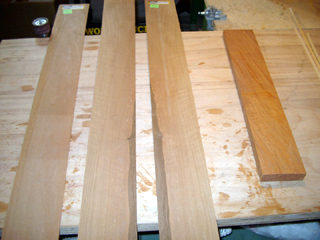 Some general things about wood. Most of the wood must be very hard. The neck must be hard to stand the string
tension without moving. The body must be hard for a good sustain, because hard materials keep the vibration longer. Imagine that you hit on metal with a hammer. It will vibrate a long time like a bell. If you imagine to knock on
a soft material like plastic, the vibration will be absorbed immediately.
Some general things about wood. Most of the wood must be very hard. The neck must be hard to stand the string
tension without moving. The body must be hard for a good sustain, because hard materials keep the vibration longer. Imagine that you hit on metal with a hammer. It will vibrate a long time like a bell. If you imagine to knock on
a soft material like plastic, the vibration will be absorbed immediately.
Only the top of the instrument can be made of softer wood. The top material is mainly responsible for the sound characteristic. Eventually, all the materials of the whole instrument make the final sound. Even the tuner type can have an impact on the sound. Nevertheless, I recommend to take hard wood for the whole instrument. This will give the typical hard, clear ukulele sound. Only if you want a soft, warm sound, then you should consider to take a soft wood for the top. For example spruce or red cedar can be used for the top. These are also the woods that are mainly used for classical guitar tops.
Mahogany is very common for the body and neck. If you don’t want to use rain forest woods, then you could take maple or walnut. I love to work with walnut. It sounds great and has a dark color and a nice structure. The traditional wood for ukuleles is Hawaiian koa wood. Koa should only be used for the body. It is too soft to be used for the neck. The fretboard is usually made of rosewood or ebony, but you can also use walnut. The nut can be made of a hard wood (ebony, rosewood, walnut). Nuts are also made of plastic, or bone. The braces are made of spruce. The linings can be made of mahogany. I use beech-tree for the linings.
Not only the type of wood has an impact on the sound. It depends how old the wood is, how it was cut, how it was dried etc. You will find several companies who offer special tonewood. Tonewood is selected carefully. It is free of knots. It is dried slowly, the humidity is controlled all the time, and the wood is turned several times during the drying process.
A good tonewood will almost not move, which is very important especially for the neck. On the other hand, tonewood is very expensive. And you should decide how much you would like to spend for the material of your first ukulele. I once used beech-tree wood for the neck, which is not very common, but I could get it cheap. I took plywood for the body, and the result was not too bad. Certainly, you cannot compare it to a koa ukulele, but probably you want to make your first ukulele to gather some experience and to establish the manufacturing process. It would be a shame to destroy nice koa wood, if you don’t feel experienced enough yet. If you decide to order tonewood, then you should make sure that it is already pre-cut to your demands. You can use wood with a thickness of about 2 mm (1/12 inch) for the top, bottom and side. The wood thickness for the neck depends on your neck design. The fretboard should be about 4 mm thick (1/6 inch).
The ukulele I crafted with the “Homemade Ukulele Method” was made of maple for the neck, ebony for the fretboard and bridge, and walnut for the body. I didn’t buy the walnut from a tonewood supplier. I saw it accidentally in a hobby shop around the corner. It was cut to 3 feet by 4 inches, and it was 1/10 inches thick . And it was very cheap. I had to glue two pieces together to be able to cut the top and back. It is common to glue two pieces together for guitar tops and backs, but for a small instrument like a ukulele, you usually cut it from one piece.

© 2009 powered by
RISA Musical Instruments
